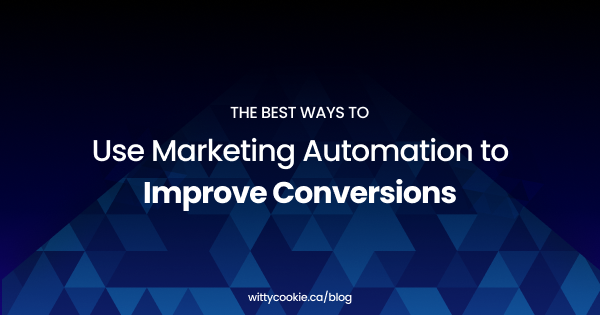The Best Ways to Use Marketing Automation to Improve Conversions
Most people would agree that marketing automation is a powerful tool that can help businesses increase their conversion rates. But all too often, businesses don’t take the time to create a marketing automation strategy that will actually work for them.
In this article, we’ll give you some tips on how to create a marketing automation strategy that drives conversions.
Understand Your Customer
First and foremost, you need to understand your customer’s journey. What are the steps that they take before they make a purchase? What do they need to know in order to make a purchase? Once you understand the customer’s journey, you can start to create a marketing automation strategy that will address their needs at each stage.
One way to get to know your target audience is to create buyer personas. Buyer personas are fictional representations of your ideal customer. Once you’ve created a buyer persona, you can start to think about what kind of content they would need to see at each stage of their journey.
Create Engaging Content
Once you know who your target audience is and what they need to see, you can start creating engaging content. Your content should be designed to educate and inform your target audience. It should also be interesting and relevant to their needs.
Make sure to use strong calls to action in your content so that your target audience knows what they need to do next. For example, if you want them to sign up for a free trial, make sure to include a call-to-action that tells them to do just that.

[Source: Pixabay]
Get The Timing Right
It’s not enough to just create great content. You also need to make sure that you’re getting the timing right. If you send out an email campaign too soon, your target audience may not be ready to purchase. On the other hand, if you wait for too long, they may forget about you entirely.
The key is to find a happy medium. You’ll need to experiment a bit to find the right timing for your business, but in general, you should aim to send out your marketing automation campaigns about a week before your target audience is ready to purchase.
Use Marketing Automation Tools
There are a number of different marketing automation tools available on the market. These tools can help you automate repetitive tasks, such as email marketing and social media posting. They can also help you track your results so that you can see what’s working and what’s not.
When choosing a marketing automation tool, it’s important to find one that integrates well with your existing systems. You should also make sure that it’s easy to use and that it has all the features you need. For instance, if you’re using WordPress, you might want to consider a tool like Jetpack. Jetpack is a plugin that comes with a number of features, including marketing automation.
If you’re new to the whole game, you should also consider using some of the top website development consultants you can find to help you out. This way, you won’t have to learn by trial and error, and you’ll be more likely to get things right the first time.
Measure Your Results
Once you’ve implemented your marketing automation strategy, it’s important to measure your results. This will help you see what’s working and what’s not. Make sure to track your conversion rates so that you can see how well your strategy is working. You should also keep an eye on your website’s traffic. This will help you see how many people are actually seeing your content and whether or not they’re taking the desired action.
Finally, make sure to monitor your social media engagement. This will give you an idea of how well your content is being received by your target audience. Tracking conversion rates is simple with Google Analytics. Simply create a goal and then track the conversion rate over time.
Monitoring website traffic is also simple with Google Analytics. Just go to the “Audience” section and then click on “Overview.” From there, you can see how many people are visiting your site and where they’re coming from. As for social media engagement, there are a number of different tools that you can use. For example, Hootsuite Insights lets you track your social media engagement and reach.
Email Automation
One of the most important aspects of marketing automation is email automation. Email automation allows you to send automatic emails to your list of subscribers. This can be a great way to stay in touch with your customers and keep them updated on your latest products and services. There are a number of different email automation tools available, so don’t be afraid to test multiple out until you find one that suits you best.
When it comes to crafting emails that need to be sent out automatically, it’s important to make sure that they’re high quality. This means that they should be well-written and relevant to your target audience. It’s also important to make sure that your emails are mobile-friendly. This is because more and more people are reading their emails on their smartphones.
Finally, make sure to include a strong call-to-action in your emails. This will help encourage your subscribers to take the desired action, whether it’s signing up for a free trial or buying a product. Here you have a list of re-engagement email examples.

Photo by Stephen Phillips – Hostreviews.co.uk on Unsplash
Web Push Notifications
Another great way to improve conversions is to use web push notifications. Web push notifications are a relatively new technology that allows you to send messages to your subscribers even when they’re not on your website. This can be a great way to stay in touch with your customers and encourage them to come back to your site. There are a number of different web push notification services available. One of the most popular is PushEngage.
To use web push notifications, you simply need to install a plugin or piece of code on your website. Once you’ve done that, you can start sending messages to your subscribers. Make sure to craft your messages carefully. They should be relevant and interesting if you want people to actually read them. You should also make sure to include a call-to-action in your messages. This will help encourage people to take the desired action, whether it’s visiting your website or buying a product.
A/B Testing
A/B testing is another great way to improve conversions. A/B testing is a process of testing two different versions of a piece of content to see which one performs better. For example, you could test two different headlines to see which one gets more people to click on an article. Or, you could test two different call-to-actions to see which one gets more people to sign up for a free trial.
A/B testing is a great way to improve conversions because it allows you to directly see which version of a headline or CTA your target audience prefers. There are a number of different A/B testing tools available. One of the most popular is Google Optimize.
To use A/B testing, simply create two different versions of a piece of content. Then, use a tool like Google Optimize to split your traffic between the two versions. Once you’ve done that, you can track the conversion rate for each version and start implementing the one that works better.
Behavior Triggers
Behavior triggers are another great way to improve conversions. Behavior triggers are a type of automation that allows you to send messages or take action based on the actions of your subscribers. For example, you could set up a behavior trigger to automatically send a message to someone who abandons their shopping cart. Or, you could set up a behavior trigger to automatically offer a discount to someone who visits your website for the first time.
Behavior triggers are a great way to improve conversions because they help you interact with the visitors of your site as soon as they enter it. This allows you to send them messages that are highly relevant to them, making them more likely to convert. To use behavior triggers, simply create a campaign and set up the trigger conditions. Then, whenever someone meets those conditions, they’ll automatically receive the message or take the desired action.
The message accompanying your trigger should be highly relevant to the person receiving it. It should also include a strong call to action, as this will help encourage them to take the desired action.
Lead Scoring
Lead scoring is another great way to improve conversions. Lead scoring is a process of assigning a score to each lead based on their behavior. For example, you could give a lead a higher score if they’ve visited your site multiple times or if they’ve subscribed to your email list. Essentially, lead scoring allows you to prioritize the leads that are most likely to convert.
To use lead scoring effectively, all you have to do is create a campaign and set up the scoring system. Then, as leads come in, they’ll automatically be given a score. You can then use this score to prioritize which leads you want to focus on first. The higher the score, the more likely they are to convert, so make sure to focus on those leads first.
Conclusion
Marketing automation is a great way to improve conversions. By using marketing automation, you can send highly relevant messages to your target audience and encourage them to take the desired action. There are a number of different ways to use it, but some of the most effective include A/B testing, behavior triggers, and lead scoring. With these tips, you’re bound to improve your conversions in no time.
Author bio
Travis Dillard is a business consultant and an organizational psychologist based in Arlington, Texas. Passionate about marketing, social networks, and business in general. In his spare time, he writes a lot about new business strategies and digital marketing for DigitalStrategyOne.



